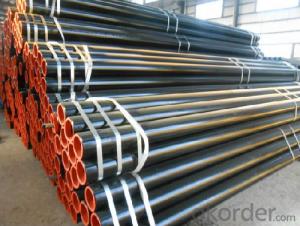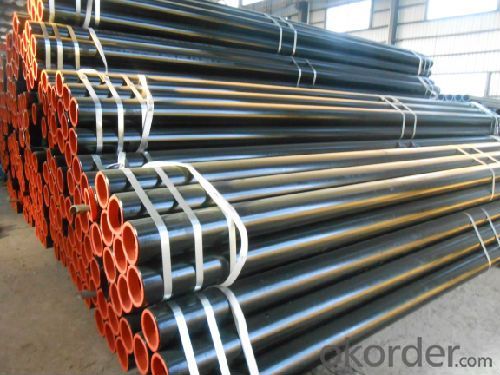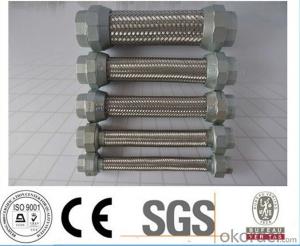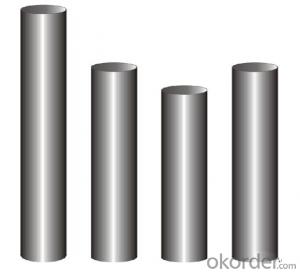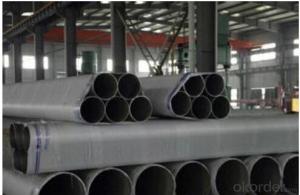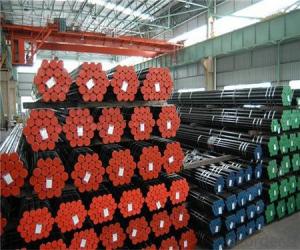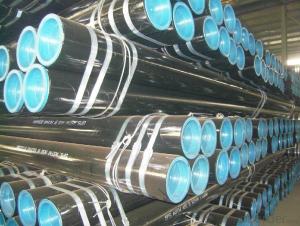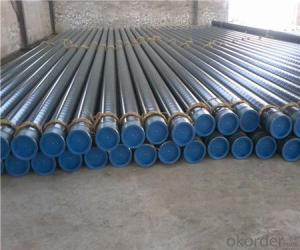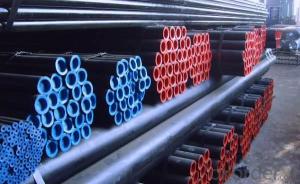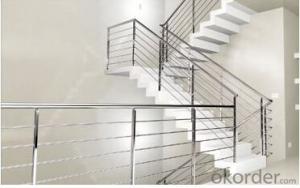Seamless Steel Pipe Line Pipe ASTM A106, ASTM A53, China Manufacturer
- Loading Port:
- China Main Port
- Payment Terms:
- TT or LC
- Min Order Qty:
- 30 m.t.
- Supply Capability:
- 12000 m.t./month
OKorder Service Pledge
OKorder Financial Service
You Might Also Like
1、Full series of products provides an easier access for one stop purchase
▲ Line pipe
▲ Tubing and casing
▲ L & M & H boiler tube
▲ Gas cylinder tube & pipe
▲ Mechanical & Structural pipe
▲ Ship-building tube & pipe
▲ Automobile tube & pipe
2、Main Features of the Seamless Pipe ASTM A106/53:
• High manufacturing accuracy
• High strength
• Small inertia resistance
• Strong heat dissipation ability
• Good visual effect
• Reasonable price
1.Seamless pipe professor
2.MTC,ISO,API certificate
3.ASTM,DIN,BS,JIS,GB
4.On time delivery
5.Big store,excellent package
3、Seamless Pipe ASTM A106/53 Specification:
Standard | GB, DIN, ASTM ASTM A106-2006, ASTM A53-2007 |
Grade | 10#-45#, 16Mn 10#, 20#, 45#, 16Mn |
Thickness | 8 - 33 mm |
Section Shape | Round |
Outer Diameter | 133 - 219 mm |
Place of Origin | Shandong, China (Mainland) |
Secondary Or Not | Non-secondary |
Application | Hydraulic Pipe |
Technique | Cold Drawn |
Certification | API |
Surface Treatment | factory state or painted black |
Special Pipe | API Pipe |
Alloy Or Not | Non-alloy |
Length | 5-12M |
Outer Diameter | 21.3-610mm |
Grade | 20#, 45#, Q345, API J55, API K55, API L80, API N80, API P110, A53B |
Standard | ASME, ASTM |
4、Packaging & Delivery
Packaging Details: | seaworthy package,bundles wrapped with strong steel strip |
Delivery Detail: | 15-30days after received 30%TT |
5、FAQ of Seamless Pipe ASTM A106/53:
①How is the quality of your products?
Our products are manufactured strictly according to national and internaional standard, and we take a test
on every pipe before delivered out. If you want see our quality certifications and all kinds of testing report, please just ask us for it.
Guaranteed: If products’ quality don’t accord to discription as we give or the promise before you place order, we promise 100% refund.
②How about price?
Yes, we are factory and be able to give you lowest price below market one, and we have a policy that “ for saving time and absolutely honest business attitude, we quote as lowest as possible for any customer, and discount can be given according to quantity”,if you like bargain and factory price is not low enough as you think, just don’t waste your time.Please trust the quotation we would give you, it is professional one.
③Why should you chose us?
● Full series of products provides an easier access for one stop purchase
▲ Electric Resistance Welded (ERW) Steel Pipe
▲ Longitudinal Submerged Arc Welded (LSAW) Steel Pipe
▲ Spiral Submerged Arc Welded (SSAW) Steel Pipe
▲ Hollow Section (Square and Rectangle Pipe)
▲ Hot Dipped Galvanized Steel Pipe
▲ Professional sales team
▲ Professional engineering and technology team
▲ Professional exportation and contract processing/management team
▲ Professional cooperators and partners
6、Seamless Pipe ASTM A106/53 Images:

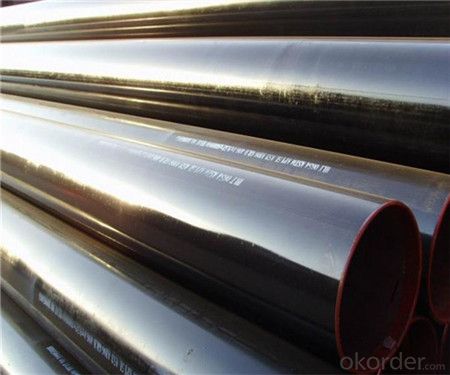

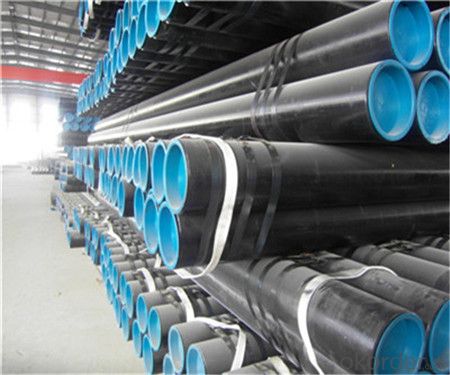
- Q: Can stainless steel pipes be heat treated?
- Indeed, heat treatment is applicable to stainless steel pipes. The procedure entails subjecting the stainless steel pipe to a particular temperature, maintaining it at that temperature for a specific duration, and subsequently cooling it in a controlled manner. This method is commonly employed to modify the mechanical properties of the stainless steel, such as enhancing hardness or bolstering strength. Furthermore, heat treatment can address stress relief and eliminate impurities in the stainless steel pipe. However, it is crucial to acknowledge that not all stainless steel grades can undergo heat treatment, as the composition of the alloy significantly influences its heat treatability. Therefore, it is advisable to consult the manufacturer or a metallurgical expert to ascertain the appropriate heat treatment process for a specific stainless steel pipe.
- Q: Are stainless steel pipes suitable for oil and gas applications?
- Yes, stainless steel pipes are suitable for oil and gas applications. They have excellent corrosion resistance, high strength, and can withstand high temperatures and pressures commonly found in oil and gas operations. Additionally, stainless steel pipes are easily maintainable and have a long lifespan, making them a reliable choice for such applications.
- Q: Can stainless steel pipes be used in the oil and gas industry?
- Yes, stainless steel pipes can be used in the oil and gas industry. Stainless steel pipes offer several advantages that make them suitable for use in this industry. Firstly, stainless steel has high corrosion resistance, which is crucial for withstanding the harsh environments and corrosive substances present in the oil and gas industry. This resistance to corrosion helps to prevent leaks and ensures the integrity of the pipes, promoting safety and reliability. Additionally, stainless steel pipes have excellent strength and durability, allowing them to withstand high pressures and temperatures that are often encountered in oil and gas operations. Moreover, stainless steel is non-reactive, meaning it does not contaminate the oil or gas being transported, ensuring the purity and quality of the product. Overall, the superior properties of stainless steel make it a preferred choice for oil and gas industry applications, providing a reliable and long-lasting solution.
- Q: What are the common applications of stainless steel pipes in the construction industry?
- Stainless steel pipes are extensively used in the construction industry due to their numerous beneficial properties. Some of the common applications of stainless steel pipes in the construction industry include: 1. Plumbing systems: Stainless steel pipes are widely used in plumbing systems for their corrosion resistance, durability, and ability to withstand high pressure and temperature. These pipes are ideal for carrying water, gas, and other fluids in residential, commercial, and industrial buildings. 2. Structural support: Stainless steel pipes are commonly used in structural applications to provide support and stability. They are used in the construction of columns, beams, and other load-bearing structures due to their high strength and resistance to deformation. 3. Handrails and guardrails: Stainless steel pipes are commonly utilized in the construction of handrails and guardrails due to their aesthetic appeal, low maintenance requirements, and durability. These pipes provide safety and security while enhancing the overall appearance of the building. 4. Ventilation and exhaust systems: Stainless steel pipes are often used in the construction of ventilation and exhaust systems in buildings. They are resistant to corrosion and can handle high temperatures, making them suitable for carrying air and gases in commercial kitchens, factories, and other industrial facilities. 5. Balustrades and staircases: Stainless steel pipes are frequently employed in the construction of balustrades and staircases due to their strength, durability, and modern appearance. These pipes offer both functionality and aesthetic appeal, enhancing the overall design of the building. 6. Conduits for electrical wiring: Stainless steel pipes are used as conduits for electrical wiring in buildings. Their non-combustible nature and resistance to corrosion provide a safe environment for routing electrical cables and wires. 7. Fire sprinkler systems: Stainless steel pipes are commonly used in fire sprinkler systems due to their ability to withstand high temperatures and corrosion resistance. These pipes ensure the effective and reliable distribution of water for fire suppression in case of emergencies. 8. Solar panel installations: Stainless steel pipes are employed in the construction of solar panel installations. They are used to carry water or heat transfer fluids for solar thermal systems, contributing to the sustainability of the building. Overall, stainless steel pipes are versatile and highly beneficial in the construction industry. Their corrosion resistance, durability, strength, and aesthetic appeal make them an ideal choice for various applications, ensuring the longevity and functionality of buildings.
- Q: Can stainless steel pipes be used for food storage tanks?
- Yes, stainless steel pipes can be used for food storage tanks. Stainless steel is a preferred material for food storage and processing equipment due to its excellent corrosion resistance, durability, and hygiene properties. It is non-reactive, does not leach any harmful substances into the food, and can withstand high temperatures and rigorous cleaning processes. Additionally, stainless steel pipes can be easily cleaned and sanitized, ensuring the maintenance of proper food safety standards. Therefore, stainless steel pipes are commonly used in the construction of food storage tanks to ensure the safety and quality of stored food products.
- Q: What is the average weight of a stainless steel pipe?
- The weight of a stainless steel pipe can differ based on its size, wall thickness, and length. Various dimensions and grades are accessible for stainless steel pipes, which can impact their weight. However, in general, stainless steel pipes are typically heavier compared to pipes made from alternative materials due to the density of stainless steel. The weight of a stainless steel pipe can range from a few kilograms to several hundred kilograms per meter, depending on the factors mentioned earlier. To accurately determine the exact weight of a stainless steel pipe for a specific application, it is crucial to refer to the product specifications or consult a supplier.
- Q: What is the difference between seamless and welded stainless steel pipes?
- The main difference between seamless and welded stainless steel pipes lies in their manufacturing process and the resulting characteristics of the pipes. Seamless stainless steel pipes are produced by piercing a solid billet or ingot, heating it to a high temperature, and then rolling it into a hollow cylindrical shape. This process ensures that there are no seams or joints in the pipe, resulting in a smooth and uniform surface. Seamless pipes are generally considered to have higher strength and better corrosion resistance compared to welded pipes. They are also preferred in applications where high pressure or temperature is involved, as their seamless nature makes them more reliable and less prone to leaks. On the other hand, welded stainless steel pipes are manufactured by joining two or more pieces of steel together using various welding techniques. This process introduces a seam or weld line along the length of the pipe. Welded pipes can be produced in a continuous or intermittent welding process, depending on the required specifications. While welded pipes may have slightly lower strength and corrosion resistance compared to seamless pipes, advancements in welding technology have significantly improved their quality and performance. Welded pipes are generally more cost-effective and commonly used in applications where lower pressure or temperature is involved. In summary, the difference between seamless and welded stainless steel pipes lies in their manufacturing process and resulting characteristics. Seamless pipes, with no seams or joints, offer higher strength, better corrosion resistance, and are preferred in high-pressure or temperature applications. Welded pipes, with welded seams, are more cost-effective, commonly used in lower-pressure or temperature applications, and have seen significant improvements in quality and performance. Ultimately, the choice between seamless and welded pipes depends on the specific requirements of the application and cost considerations.
- Q: Are stainless steel pipes suitable for construction projects?
- Yes, stainless steel pipes are highly suitable for construction projects. They offer exceptional strength, durability, and corrosion resistance, making them an ideal choice for various applications in construction, including plumbing, HVAC systems, structural supports, and more. Stainless steel pipes also have excellent aesthetic appeal and can withstand harsh environmental conditions, making them a reliable and long-lasting option for construction projects.
- Q: Can stainless steel pipes be used in drinking water systems?
- Yes, stainless steel pipes can be used in drinking water systems. Stainless steel is a highly durable and corrosion-resistant material that can withstand the harsh elements present in water systems. It does not leach any harmful substances into the water, making it a safe choice for drinking water applications. Additionally, stainless steel pipes are easy to clean and maintain, further ensuring the quality and safety of the drinking water.
- Q: How do stainless steel pipes compare to copper nickel pipes?
- Various industries commonly utilize stainless steel pipes and copper nickel pipes due to their unique properties and advantages. Although their purposes are similar, there are notable distinctions between the two. To begin, stainless steel pipes consist of an alloy primarily composed of iron, with substantial amounts of chromium and other elements. They exhibit exceptional resistance to corrosion, making them suitable for applications that prioritize durability and longevity. Additionally, stainless steel pipes possess considerable strength, rendering them ideal for high-pressure environments. Furthermore, they can withstand extreme temperatures, making them suitable for a wide array of applications. On the other hand, copper nickel pipes are comprised of an alloy that combines varying proportions of copper and nickel. These pipes possess high resistance to corrosion, particularly in seawater environments, which makes them highly useful in marine applications. Furthermore, copper nickel pipes exhibit excellent thermal conductivity and resist biofouling, making them suitable for heat exchangers and condensers in diverse industries. Regarding cost, stainless steel pipes generally offer a more affordable option compared to copper nickel pipes. The price difference can significantly impact decisions involving large-scale installations or projects with budget constraints. Furthermore, the selection between stainless steel and copper nickel pipes depends on specific requirements and conditions. For instance, if corrosion resistance is the primary concern, copper nickel pipes would be the preferred choice, especially in marine environments. Conversely, if strength, durability, and versatility are paramount, stainless steel pipes would be the superior option. In conclusion, stainless steel pipes and copper nickel pipes each possess distinct advantages and applications. Both materials are excellent choices for various industries, but the ultimate decision relies on factors such as corrosion resistance, strength, thermal conductivity, and budget considerations.
Send your message to us
Seamless Steel Pipe Line Pipe ASTM A106, ASTM A53, China Manufacturer
- Loading Port:
- China Main Port
- Payment Terms:
- TT or LC
- Min Order Qty:
- 30 m.t.
- Supply Capability:
- 12000 m.t./month
OKorder Service Pledge
OKorder Financial Service
Similar products
Hot products
Hot Searches
Related keywords
